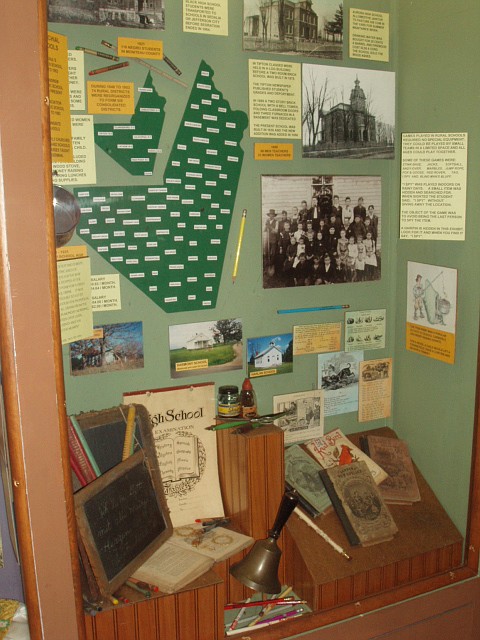By RICHARD SCHROEDER
Museum Chairman
Education, in what was to become Moniteau County, started in 1825 when Rev. David Allee erected a log schoolhouse about a mile and a half northeast of Clarksburg where he taught school at his own expense. When Moniteau County became a county in 1845 there were nine township schools. These were all poorly lighted and cramped. Students sat on log benches and listened to the single teacher. There were no books except the Bible and nothing to write on except slates, which were rare. Early schools were taught in churches that taught religion and German. As neighborhoods organized, school boards were selected to provide the bare necessaries for education which consisted simply of the three R's; Reading, 'riting 'and 'rithmetic. The center of this display shows the 1945 location of 77 one room country schools. In 1948 these schools were consolidated and reorganized into six school districts. The old schoolhouses were claimed by the farmer who kept hay, tools, hogs or dogs in them.
Public schools were supported by taxes to educate children to the eighth grade or until they dropped out. Private schools developed to provide further education and there were academies in Jamestown, and California in 1858 and Tipton Seminary in 1859. Hooper Institute in Clarksburg was an important school for advanced education that included foreign language and elocution. It was a prep school for students interested in becoming teachers, lawyers and doctors. Clarksburg had a second school, Clarksburg College. The California Academy charged a student 50 cents a month, $1.00 if the teacher was a lady and $2.00 if the study of French was included. The old Akinsville Institute building in Morgan County was picked up and moved to Fortuna to become Fortuna's first school house. California had one of the first high schools in the state. All county schools closed during the Civil War.
African-American children were forbidden to attend schools or read any books until they were emancipated during the Civil War. The history of their struggles to become educated is a telling story. The county school census in 1900 showed there was a total of 4,131 students in Moniteau County. One hundred eighty three of these students were Negro. Negro students in California went to Humbolt School. The site is now the location of Pentecostal Life Church on North Owens Street. There were 30 students that each cost the county 10 cents a day. Harrison School was for Negro students in Tipton. This building is still standing and is named Genesis II and serves as a spiritual renewal facility. If Negro students wanted to attend high school they were transported by bus to Lincoln Labratory School in Jefferson City or to Sedalia.
The U. S. Supreme Court declared segregation illegal in 1954 and black children were integrated into the public school systems. The first year of desegregation California High School elected a black student, Ollie Jackson, as their student body president.
Aurora High School in California allowed their janitor to graze his cow on the school grounds and sold the wood ashes from the school stoves to make soap. This historic school burned in 1929. Students were schooled in the courthouse and churches.
Annunciation Catholic school opened and closed several times and switched from Catholic sisters as teachers to lay teachers and back again several times. St. Andrew Catholic School in Tipton continued to operate without disruption and today it remains an active successful school. There are Old Order Mennonite schools that operate as one room schools without electricity.
Early teachers were men. They had discipline problems with bigger students and were often assaulted. Discipline was severe. In 1880 sixty-eight teachers were men and 33 were women. When things calmed down girls and unmarried women were hired by local school boards as teachers. They boarded with nearby families and often shared a bed with a child. Male teachers were paid $104 and month. Female teachers were paid $82.
Schools served as rural social centers with box suppers, plays, recitations and spelling bees. These were considered responsibilities of the teacher. The display includes a hidden hair pin that visitors are challenged to find in a game of "I Spy" which was one of many games played by students for recreation. Sixty percent of high school age students did not attend school in 1930-1931. The older students were needed on the farm.
Much of this information is from a book by Dr. Larry Fletcher, Moniteau County School History, 1810 - 1984. This book is available at the Genealogy Library next to the museum.

